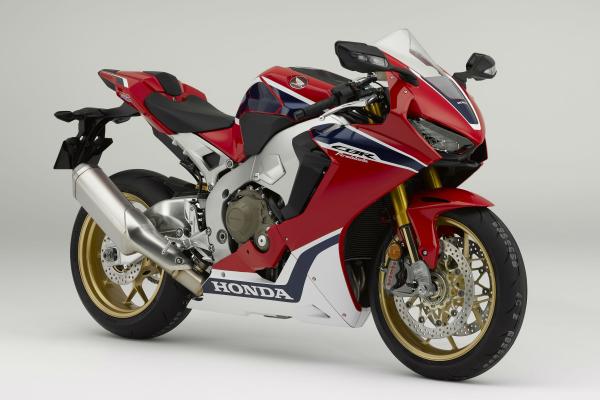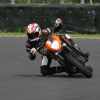
THERE HAS been lots of rumour and speculation about what to expect from the next-generation Honda Fireblade but in a press conference at the Intermot show in Germany, Honda today unveiled its new 2017 CBR1000RR Fireblade SP and the homologation special SP2.
Key information:
- Ohlins semi-active suspension
- Inertial measurement unit and a full suite of electronics
- Cornering ABS
- Quickshifter and downshift assist
- RC213V-S derived traction control
- Inertial measurement unit
- Riding and power modes
Since the ‘Blade was last updated, superbikes have become increasingly more powerful and technologically advanced, so it’s not surprising that the latest incarnation of Honda’s flagship sports bike sees the Fireblade gaining a comprehensive suite of electronics.
Honda says its main focus when developing the 2017 Fireblade was power-to-weight, which were principles of the original ‘Blade, released 25 years ago. It says the focus on this machine has been cornering, acceleration and braking. Here it is in more detail:
Engine
The Fireblade is still powered by a 999.8cc inline four-cylinder engine with a bore and stroke of 76 x 55.1mm.
Honda says the CBR’s low-end torque and power are improved, along with a significant increase in top end power. The new ‘Blade makes a claimed 189hp at 12,500rpm - an 11hp increase over the outgoing model.
The engine revs harder and higher than before (up to 13,000rpm), and uses a higher compression ratio (up from 12.3:1 to 13:1) along with revised valve lift and cam timing.
According to Honda, the pistons have an optimised wall thickness and a new crown design, and the surface finishing of the piston ring grooves has been modified to improve performance and efficiency.
Throttle bore has increased by 2mm to 48mm, with the intake funnels shaped to provide a linear throttle response.
The engine weighs a claimed 2kg less than the previous motor, thanks to use of magnesium covers and ‘detail redesign’ – shorter bolts, water hose and water hose bands.
The radiator is 30mm narrower, 30cc smaller and a claimed 100g lighter, and Honda says it provides identical heat dissipation to the previous rad.
The exhaust silencer is made from titanium, as is the 16 litre fuel tank. Both are intended to cut weight and aid mass centralisation.
The slipper clutch has been redesigned to offer less load and more feel at the lever.
Electronics
The 2017 Honda CBR100RR Fireblade SP1’s comprehensive suite of electronics is based around a five-axis Bosch inertial measurement unit (IMU) .
The IMU knows wheel and engine speeds, brake input and throttle position and works with the traction control (called HSTC – Honda Selectable Torque System) and cornering ABS systems to allow optimum acceleration out of corners, plus hard trail braking (which it does by monitoring deceleration and lean angle to vary the threshold for ABS decompression).
The HSTC system is, Honda says, an advanced version of what’s on the RC213V-S. It senses differences in wheel speed, plus the bike’s roll angle, roll and yaw directions and acceleration across three planes to maintain traction and drive. The HSTC has nine levels of intervention and can be turned off.
There’s also a system called SEB (Selectable Engine Braking) to alter the amount of engine braking on offer.
The new CBR1000RR also has active Ohlins front and rear suspension, controlled by a Suspension Control Unit (SCU), which adjusts compression and rebound damping.
There’s a quickshifter and Dowshift Assist for clutchless up and downshifts. Both systems work by injection cut and retard, with three different settings.
The new ‘Blade also boasts wheelie control and rear wheel lift control, which is designed to allow for hard braking while maintaining the rear wheel’s contact with the ground. Whether that means no backing it in at all remains to be seen.
As part of the Fireblade’s RMSS (Ride Mode Select System), there are two sets of three riding modes – three active modes (Track, Sport and Comfort) and three manual modes which allow the rider to set the bike up to his or her preference. Adjustments can be made to the active modes as well.
Complimenting the riding modes is the Power Selector, which offers three levels of power output and is accessed through the RMSS system.
Chassis, suspension and brakes
We saw in recent spy photos that the new Fireblade looks very similar to the previous model and appears to have the same frame, although now we know that it’s not gone unchanged.
Honda says its adjusted the frame’s rigidity balance, so it’s now 10% more flexible in the torsional plane – a change designed to make the chassis feel more reactive. It’s also got thinner walls to save a claimed 500g. Honda also says the aluminium subframe is also 800g lighter.
The swingarm is claimed to be stiffer and lighter thanks to adjustments made to its thickness at various points.
At 1,404mm, the 2017 Fireblade’s wheelbase has been shortened by 6mm the seat height has increased by 11mm to 831mm.
The bike has gained an electronic steering damper.
Stopping power at the front wheel is taken care of by a set of four-piston radially mounted Brembo monoblocs with newly developed hight coefficient of friction pads, which Honda says are suited to aggressive riding.
The wheels are new too, with a Y-shape design, that saves approximately 100g. The front wears a 120/70 tyres and the rear is shod with a 190/50 R17.
The CBR1000RR also gains a full colour TFT liquid crystal dash, which adjusts to the ambient light. The dash information displayed on the dash depends on which one of its three modes its in – Street, Circuit or Mechanic.
All the lights are LED, and the twin front headlights have high/low beam on both sides.
Honda says the two best words best used to describe the styling of the new CBR1000RR are 'minimal' and 'dynamic'. Honda says its concentrated on reducing the surface area of the upper and middle fairings, and has shaved 24mm off the width of the upper fairing and 18mm from the side fairing.
Syling-wise, we think it looks evolutionary, not revolutionary but it has been sharpened up and feels like a logical next step in the Fireblade's design. From the side it has echoes of the CBR600RR.
Honda CBR1000RR Fireblade SP2
The SP2 version of the 2017 Fireblade is a homologation special, which uses the SP as the base.
At 195kg, it weighs just one kilogram less than the SP, a saving which could be credited to the Marchesini wheels.
Changes over the SP include a revised cylinder head, which uses 31.5mm diameter intake valves (1mm larger than the SP’s) and 25.5mm exhaust valves (an increase of 1.5mm over the SP). Valve angles have also been altered from 11 degrees for intake and exhaust to 10 and 12 degrees respectively.
The compression ratio is unaltered but the valve shapes and combustion chambers have been optimised for efficiency, Honda says. It runs elongated spark plugs and an RC213V MotoGP-derived water jacket tightly wrapped around the combustion chambers is intended to improve cooling.
The pistons are also altered over the standard SP. Honda says they use an exclusive crown design with heat treatment that strengthens the area around the piston boss, which uses a 2.5mm shorter (and claimed 8g lighter per cylinder) piston pin. The diameter of the valve lifter has also grown 2mm to 28mm.
The SP2 also has programmable launch control, a pit lane limiter, five-level power selector.
Here's a walkaround video of the Fireblade SP2 at Intermot:

